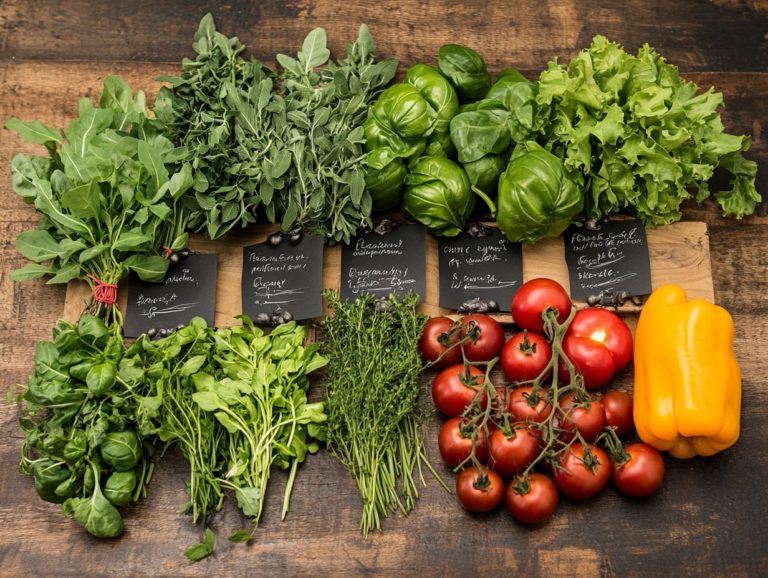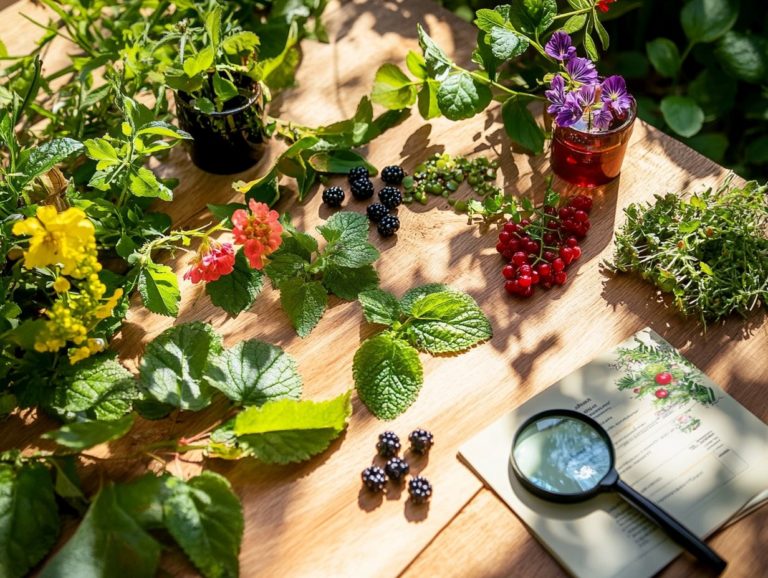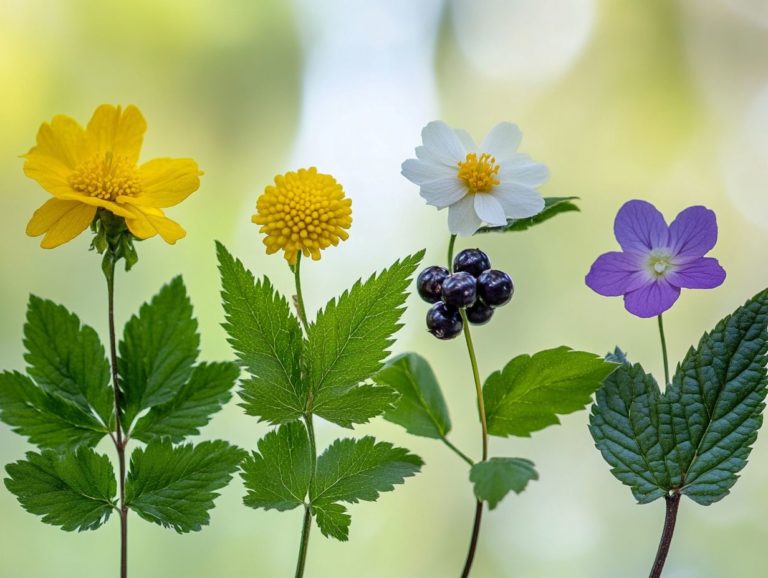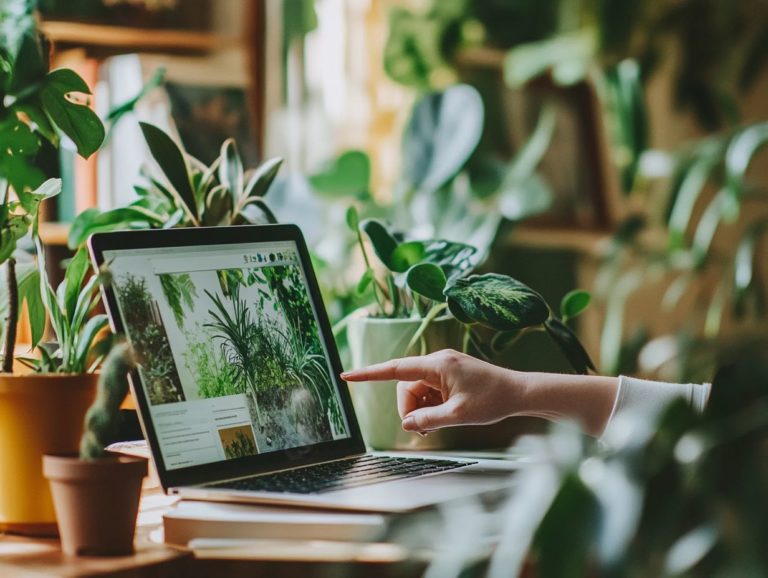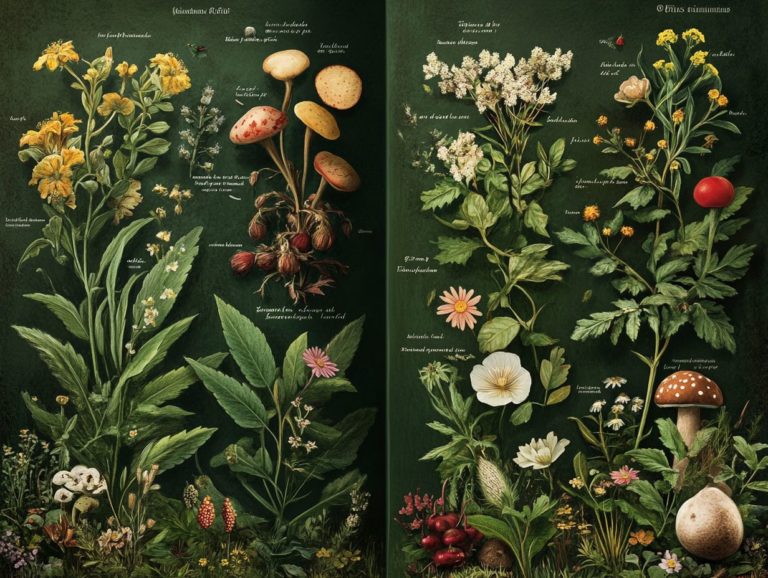The Basics of Foraging: Identifying Edibles
Foraging transcends being merely a trendy pastime; it invites you into the heart of nature, creating a strong bond with your environment while providing an array of benefits.
Imagine enhancing your health with nutritious wild foods while simultaneously championing environmental sustainability this is what foraging offers to you.
You can delve into the world of common edible plants and fungi, mastering the art of identifying and harvesting them safely. You ll also learn vital precautions to steer clear of their poisonous lookalikes.
Consider the ethical aspects of foraging and discover resources that will enrich your understanding.
Are you prepared to unearth the wild bounty that surrounds you? Join us in discovering the wild treasures waiting for you!
Contents
- Key Takeaways:
- Benefits of Foraging
- Common Edible Plants and Fungi
- Safety Considerations
- Foraging Ethics and Sustainability
- Resources for Learning More About Foraging
- Frequently Asked Questions
- What is foraging and why is it important?
- How do I identify edible plants while foraging?
- Are there any plants that should be avoided while foraging?
- What are some common edible plants that can be found while foraging?
- Can I forage in any location?
- How should I properly harvest and prepare edible plants while foraging?
Key Takeaways:
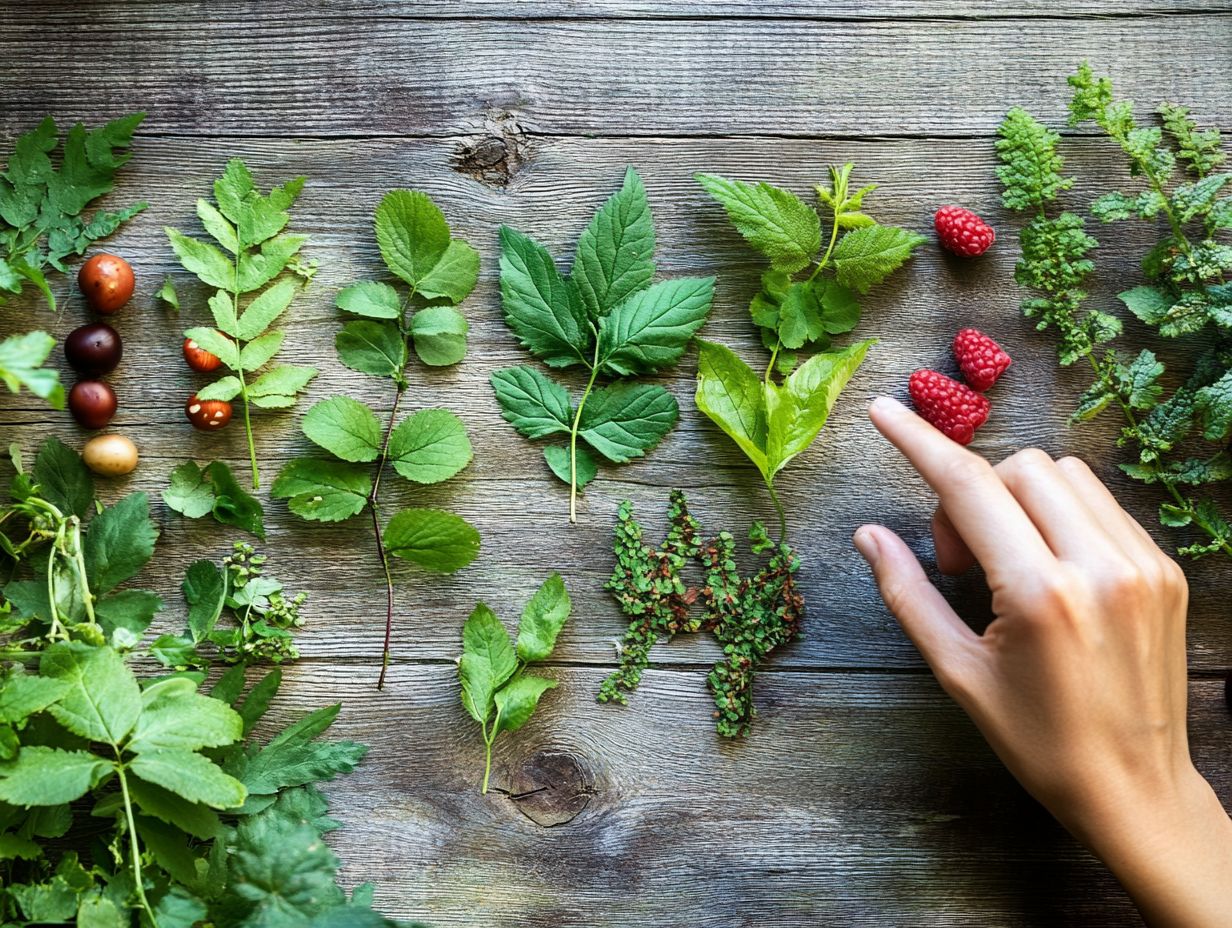
- Foraging means picking wild plants and mushrooms to eat, offering many health and environmental benefits.
- It is important to identify and harvest edible plants and fungi properly, understanding safety precautions and avoiding poisonous lookalikes.
- Foraging should be done responsibly and sustainably, following ethical principles, and there are many resources available to help you learn more about foraging.
What is Foraging?
Foraging is an art, a delightful journey of searching for and gathering wild edibles like plants, mushrooms, and fruits that nature graciously offers. This sustainable approach to sourcing food not only deepens your connection to the environment but also enriches your understanding of local ecosystems.
It promotes healthy eating and a resourceful lifestyle. As you delve into foraging, you ll explore diverse habitats, identify wild plant species, and engage in hands-on learning experiences that foster a sense of community, often guided by the wisdom of seasoned foragers.
Historically, foraging has been an essential survival skill woven into the fabric of human evolution when our ancestors relied entirely on nature to fulfill their dietary needs.
Today, this time-honored practice has regained its importance as people like you seek to reconnect with the land and embrace a more sustainable lifestyle. The ability to identify edible plants is crucial after all, misidentification could pose serious health risks.
Gaining practical experience is invaluable; many find that learning from the community enhances their foraging skills. This allows you to share insights with fellow enthusiasts who share your passion for wild edibles.
With thriving workshops and local foraging groups, you not only benefit from fresh, nutrient-rich food but also forge lasting connections within your community.
Benefits of Foraging
Foraging offers numerous benefits that beautifully intertwine health advantages with environmental sustainability, making it a truly rewarding endeavor for both you and the ecosystems around you.
By gathering wild edibles like dandelion leaves and wild berries, you can enrich your diet with nutrient-dense foods while fostering biodiversity the variety of different plants and animals through the responsible collection of these plants.
This practice not only deepens your understanding of seasonal resources but also encourages a thoughtful approach to food sourcing one that honors and respects the delicate balance of nature.
Health and Environmental Benefits
The health benefits of foraging are truly remarkable. It grants you access to wild foods that often surpass cultivated varieties in nutrient richness. This supports a healthier lifestyle.
Engaging in foraging not only enhances your well-being but also helps environmental health by promoting biodiversity and encouraging sustainable practices. You ll find yourself carefully selecting local edibles while prioritizing food safety. This enriching experience deepens your connection to nature.
These wild foods do more than just elevate your health with their impressive vitamin and mineral content; they also play a vital role in maintaining the delicate balance of local ecosystems. When you forage mindfully, you help control plant populations and prevent the overgrowth of invasive species, nurturing healthier habitats.
This practice sharpens your food safety skills and makes foraging even more exciting, especially when you learn the dos and don’ts of foraging, allowing you to identify edible species while steering clear of toxic plants.
By embracing foraging, you nurture your personal well-being and foster a thriving environment where biodiversity and sustainability can flourish together.
Common Edible Plants and Fungi
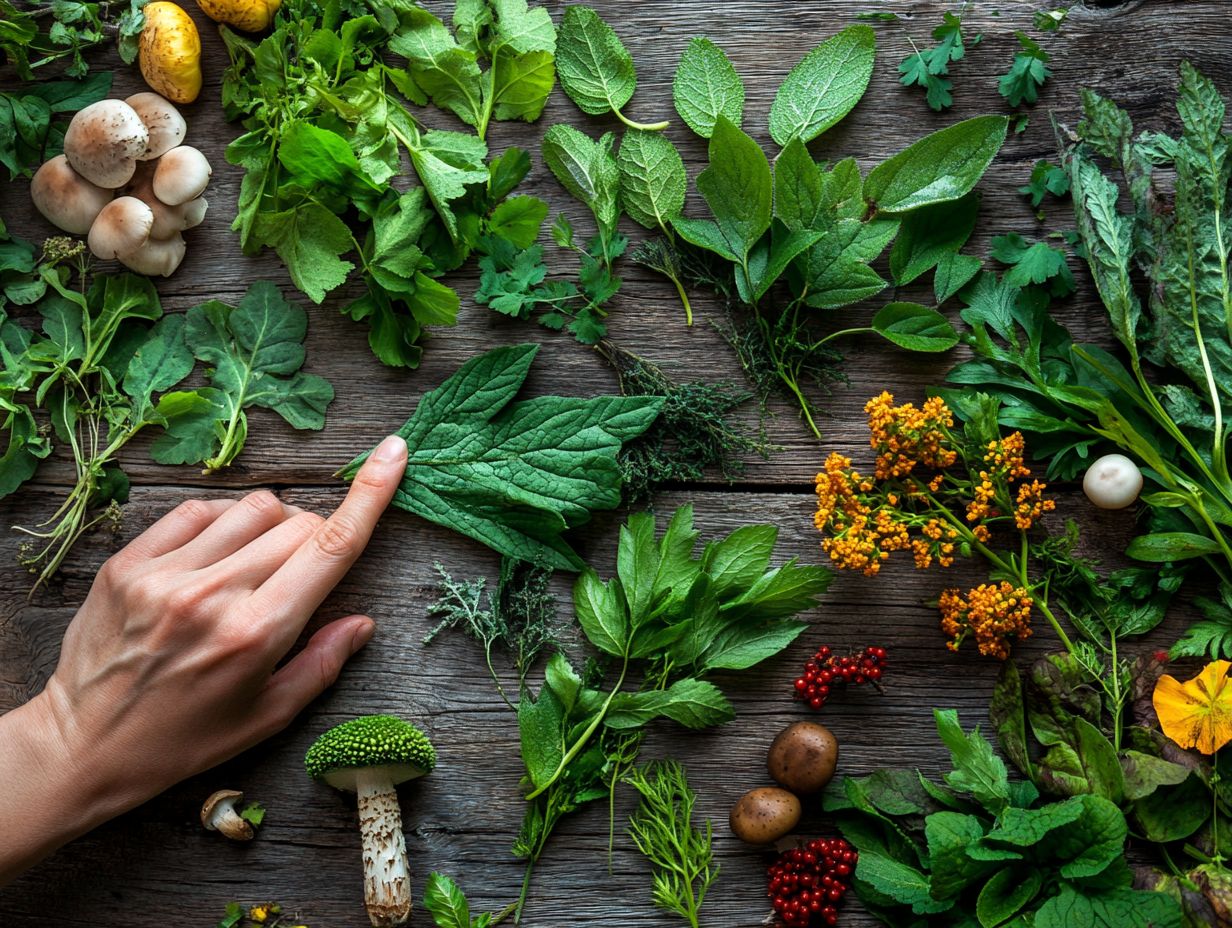
Understanding common edible plants and fungi is crucial for anyone keen on foraging. This knowledge helps you identify safe and nutritious wild edibles.
From well-known species like dandelion and chickweed to unique discoveries like morel mushrooms and prickly pear cactus, you can significantly expand your cooking options by learning the identifying features and preferred growing conditions of these edible varieties.
Mastering plant identification not only elevates your foraging experience but also ensures safety in the wild foods you gather. Knowing what to look for when foraging is essential for a successful outing.
Identifying and Harvesting Edibles
Identifying and harvesting wild edibles demands a discerning eye and a solid grasp of the unique characteristics that distinguish various plants. For more information on this topic, check out the basics of foraging: identifying edibles. This understanding is essential for you to forage both safely and effectively.
To elevate your foraging skills, consider employing a range of techniques. Start by observing your surroundings for plants that flourish in specific conditions, as these often hint at their edibility. Additionally, what beginners should know about foraging includes recognizing the seasonal changes in these plants; some species may only be safe to eat during particular times of the year.
Engaging with local foraging groups or attending workshops can offer you invaluable insights from seasoned foragers. By blending traditional methods with modern technology, such as plant identification apps, you can swiftly verify your finds. This approach allows you to immerse yourself in outdoor adventures, exploring the rich and diverse world of wild edibles in your backyard with confidence and peace of mind.
Safety Considerations
Safety should be your top priority when foraging. The risks associated with consuming wild edibles demand a comprehensive understanding of safety guidelines and precautions.
Be vigilant about toxic look-alikes, like the Death Cap mushroom and Monkshood, which can present serious health hazards. If you have food allergies, exercise caution and consult trustworthy resources to ensure safe consumption.
Dive into a thrilling foraging adventure to prioritize your health and well-being!
Precautions and Poisonous Lookalikes
When you venture into foraging, taking the right precautions is essential to avoid dangerous encounters with poisonous plants that can closely resemble their edible counterparts. To get started safely, consider exploring the top 5 wild edibles for beginners. Pay attention not only to the leaves and blossoms but also to the habitat and growth patterns of the plants.
Familiarizing yourself with the various stages of a plant s life cycle is crucial. Some toxic look-alikes may only reveal their harmful nature at certain times. For instance, the new growth of certain herbs can easily mimic those of more dangerous species.
It s wise to consult guides or apps dedicated to plant identification, but seeking a second opinion from an experienced forager can provide an extra layer of safety.
Ultimately, the secret to successful and enjoyable wildcrafting lies in thorough research and unwavering vigilance.
Foraging Ethics and Sustainability

Foraging ethics and sustainability are vital for responsible practices. They help preserve wild resources for generations to come.
By following these ethical guidelines, you can minimize your environmental impact while actively contributing to the stewardship of your local ecosystems.
Responsible foraging means respecting habitats, harvesting only small portions, and participating in community efforts to share knowledge and resources about sustainable practices.
Principles for Responsible Foraging
Responsible foraging emphasizes respectful harvesting techniques. This safeguards both wild edibles and their ecosystems.
Adhere to guidelines such as collecting only small portions and avoiding over-collection. Gaining a thorough understanding of the plants you gather is essential.
Engaging with local communities is vital. Sharing knowledge and respecting traditional practices enriches your foraging experience, strengthens community bonds, and fosters the preservation of local biodiversity.
By understanding the seasonal cycles of wild edibles, you can elevate your practice and gather in harmony with nature.
Embracing a commitment to caring for the environment inspires you to leave places better than you found them. This ensures that these precious natural resources remain abundant for future generations.
Resources for Learning More About Foraging
Exploring the best local resources for foraging edibles is essential for anyone eager to enhance their skills in identifying wild edibles and gathering them safely.
A wealth of books and websites offer extensive insights into edible plants and fungi. Local classes, foraging workshops, and herbal courses provide invaluable hands-on experiences that enrich your understanding of this rewarding practice.
By engaging with these resources, you can cultivate confidence and establish a solid foundation for your foraging journey.
Books, Websites, and Local Classes
Books, websites, and local classes are invaluable for you as a forager eager to deepen your understanding of edible plant identification and safe harvesting techniques.
For example, titles like “Edible Wild Plants: Wild Foods from Dirt to Plate” by John Kallas and “The Forager’s Harvest” by Samuel Thayer serve as excellent starting points. Additionally, you can refer to Wild Edible Plants: A Beginner’s Guide, which offers identification tips and culinary insights to elevate your foraging game.
Websites such as Wild Food UK and the Forager’s Forum foster vibrant online communities where you can share experiences and seek answers to your questions.
Nearby classes provide workshops led by seasoned foragers. Joining a group or participating in a guided walk can enrich your understanding and cultivate relationships with fellow enthusiasts, transforming the learning journey into a truly enjoyable experience.
Frequently Asked Questions
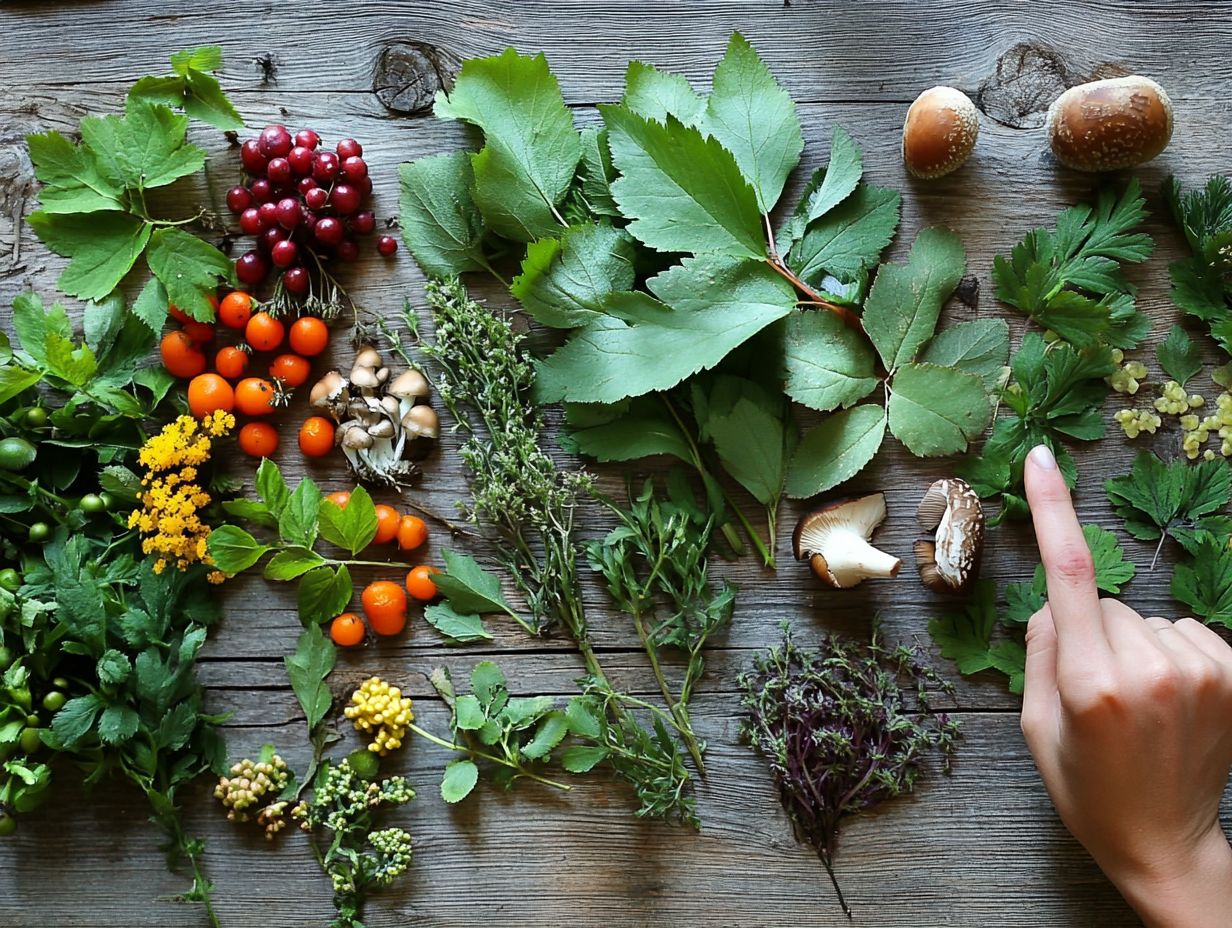
What is foraging and why is it important?
Foraging means finding and gathering wild plants for food. It connects us to nature and adds nutritious variety to our diets.
How do I identify edible plants while foraging?
Learn the distinct features of plants before foraging. Look for leaf shape, size, and color to identify them accurately.
Are there any plants that should be avoided while foraging?
Yes, avoid plants you’re not completely sure are edible. Some may have poisonous look-alikes, so always identify them correctly.
What are some common edible plants that can be found while foraging?
Dandelion, wild berries, ramps, and chickweed are excellent choices. Remember, the availability of these plants changes based on your location and the season.
Can I forage in any location?
It’s essential to ask for permission before foraging on private property. Also, steer clear of areas that might be contaminated with pesticides or pollutants.
How should I properly harvest and prepare edible plants while foraging?
Only take what you need when harvesting. Leaving some for other foragers and wildlife helps maintain the ecosystem.
Before eating, clean and prepare the plants properly. Some require cooking or other methods to ensure they’re safe to eat.

